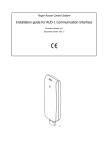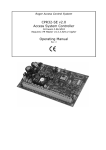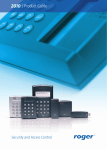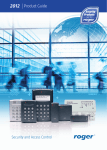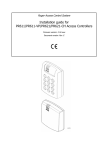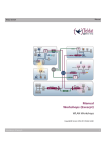Download C P R 3 2-SE
Transcript
CPR32-SE_EN.doc www.roger.pl C P R 3 2-SE CONTROL PANEL FOR ROGER ACCESS CONTROL SYSTEM Introduction The CPR access control panel is a part of Roger Access Control System (RACS). Generally the device is dedicated for systems which incorporate PR301 and PR201 access controllers but it can also be used with newly developed PRxx2 series (PR302, PR302LCD and PR402). The main function of CPR is to collect all events which occurred on access controllers and save them in its internal memory buffer. When CPR is used with PRxx2 controllers (which are equipped with events memory) it might be used as remote, “high security” events buffer, when CPR operates with PRxx1 controllers it delivers events buffering function plus controls time related functions on controllers (when operating in standalone mode PRxx1 controllers doesn’t offer time schedules nor events buffering). Note: For access systems managed by RACS 3 version software the use of CPR control panels is obligatory, the newly developed RACS 4 access system managing software may operate with systems (or networks) which are equipped with CPR control panels or which are not. When RACS 4 is used to manage access networks which incorporate PR301/201 access controllers but without CPR the RACS 4 delivers real time clock to PR301/201 controllers and register events which occurred in system, without computer in on-line mode both mentioned functionality disappears. Specification - 1.5A buffered power supply, battery backed up time/date clock, flash memory for configuration and events history, 256.000 event memory buffer, RS485 interface, Alarm output, TAMPER input, battery protection against deep discharge, battery charging control circuit, metal case with compartment for 7Ah battery. 04-06-23 Connection Terminals Description Battery Connection – RED and BLACK wires A 12V 7Ah rechargeable battery is used as a backup source of power in the event of an AC power failure. The battery also provides additional current when the equipment connected to panel demands exceed the power output of the transformer, such as when door strike energizing or activating signaling device (e.g. alarm siren). Electronic circuit monitors reserve battery voltage level, when it falls below ~12V the Low Battery alarm is signalized, when it falls below ~11.5V the Battery Failure alarm is signalized, when battery level drop below ∼10V electronic circuit automatically disconnect battery, entire system goes down. Automatic disconnection of battery protects it from deep discharge and access system from operation below minimum acceptable supply voltage. CPR charges battery with stable current, this method guarantee relatively quick and safe battery charging process. The supply output voltage is factory set to 13.8V but it can vary from 11.0 to 13.8V, this depends on actual battery charging phase. When output level is above 13.5V it means that battery is nearly charged, when levels drop below 12.0V it indicates that battery is on beginning phase of charging. Note: Do not connect the battery until all other wiring is complete. Connect the battery before connecting AC. Connect the RED battery lead to the positive battery terminal; connect the black lead to negative. AC terminals - AC The panel requires 18-22V 30VA transformer. Connect the primary side of transformer to unswitched AC source and secondary side to AC terminals. Note: Do not connect transformer until all other wiring is complete. Auxiliary Power Terminals – [+AUX-] These terminals provide up to 1A of additional current at 12V DC for devices requiring power. Connect the positive side of any device requiring power to AUX+ terminal, the negative side to AUX- (GND-ground). The AUX output is protected, when too much current is drawn from these terminals AUX output will be temporarily shut off until the problem is corrected. Communication Lines – A and B CPR is equipped with RS485 communication interface. This standard of transmission guarantee up to 1200 meters communication distance with high immunity against interferences. Installer may use arbitrary communication bus topology (star, three or any combination of both), no terminating resistors are required. In most cases communication runs satisfactory on almost each types of cables (twisted/untwisted, shielded/unshielded) but it is not guaranteed in each case. Generally unshielded, twisted type cables are preferred and guarantee best performance of communication. Installation TAMPER Input – IN2 Locate the panel in a dry area close to unswitched AC power source. CPR should be mounted in protected location, all electrical connections must be made with power supply off. This input is dedicated to supervise TAMPER contacts of CPR and other devices installed in access system. Normally this input must be shorted to supply minus (GND –ground), this situation is achieved when all TAMPER contacts are closed. If at least one TAMPER contact is open a TAMPER alarm is generated. Note: You must complete all wiring before connecting the battery, or applying AC to the panel. ALARM Output – REL1 (NO1, COM1, NC1) Once wiring is complete, power up the control panel. First connect the RED battery lead to the positive terminal and the BLACK to lead to negative. Then, connect the AC. The panel must be thoroughly tested to ensure that all features and functions are operating. ! ! ! ! ! We recommend to ground AUX minus terminal (connect to earth), Do not connect AUX plus output with other supplies plus outputs, The minus terminals of each power supply and CPR should be connected together, this will guarantee that each GND will have the same potential referred to earth, Do not change settings of potentiometers located on CPR board, CPR panel can be connected to RACS communication bus (A and B lines) in any location Memory Reset Procedure The MEMORY RESET procedure clears all existing data in CPR memory (configuration settings and events register). The CPR Memory Reset can be performed from PR Master software (“Initialize” command) or can be performed in hardware manner. The second method requires following steps: Press Memory Reset switch and keep it pressed, While Memory Reset switch is pressed press for a moment uP Reset switch, Release Memory Reset switch, The entire contents of CPR memory will be erased, panel requires new programming. Note: The device is delivered with empty (default) configuration settings and do not require the memory reset procedure. An ALARM line is an open drain, N-MOS type, transistor output. This output can sink up to 1A current for unlimited time. In normal (not triggered) condition output remain in high impedance state, when triggered it move to low resistance state which results that supply minus is observed on output. Cancel Input – IO1 This input can be used to cancel alarm signalization on REL1 output and on optional BUZZER connected to IO2 line. This input became triggered when shorted with supply minus (GND - ground). BUZZER Output – IO2 This output is dedicated to control an optional BUZZER which can be used to signalize alarm and other condition of CPR control panel. The IO2 line is an open drain transistor output which normally stay in high resistance state, when triggered it switch to supply minus. The maximum current which may be sink by this output is internally limited to 1A value. Note: BUZZER connect to IO2 output must have internal generator circuit with nominal 12V DC supply voltage. Additional Supply Terminals – TMS+ and TMSThese terminals provide up to 200mA of additional current at 12V DC for devices requiring power. Connect the positive side of any device requiring power to TMS+ terminal, the negative side to TMS-- (GND-ground). The TMS output is protected, when too much current is drawn from these terminals TMS output will be temporarily shut off until the problem is corrected. Reserved Terminals – REL2, IN2, IN3, IN4, CLK, DATA Those terminals are reserved for further use, actually they have not assigned any functionality. CPR32-SE_EN.doc www.roger.pl 04-06-23 Functional Description The CPR control panel may operate in ON or OFF mode. When CPR is stay in ON mode it continuously downloads events which had been occurred on all access controllers located in network and save them in its internal memory banks, additionally it controls time related functions (e.g. time schedules) on PR301/PR201 controllers. When CPR stay in OFF mode it stops its normal operation – this mode is dedicated for service purpose only. Generally the CPR control panel is dedicated for access control systems which use PR301 and PR201 controllers. Those controllers are not equipped with internal events buffers nor real time clocks – CPR delivers both this features to PR301/PR201 family. When CPR is used in systems which incorporate PRxx2 series of controllers it operates as remote and high security events buffer only. The PRxx2 controllers are equipped with internal memory buffers and real time clock – the lack of CPR doesn’t reduce PRxx2 functionality. The CPR can be used in mixed systems which are equipped with PRxx1 and PRxx2 series controllers, it automatically adopts its operation to different types of controllers which are installed in access network. Ordering information CPR32-SE CPR control panel with metal case. CPR32-SE-MOD CPR control panel electronic module (without casings). Technical Specification Power supply Firmware upgrade The internal control program of CPR’s microcontroller can be upgrade with new firmware versions. The procedure of upgrade is called flashing and can be performed by authorized person (installer) without replacement of any memory chips nor returning device to manufacturer. The detailed description of firmware upgrading can be found in Firmware Upgrade manual which can be downloaded from www.roger.pl 220..230V AC Power consumption: 30W Supply Output (nominal) 13.8 V dc Battery Charging Current ∼300 mA Battery Cut Off Level ∼ 10.0 V Optical and Acoustic signalization Operating temp. range 0...+55º C. Every alarm situation is signalized through LED located on CPR board and on BUZZER and ALARM outputs. The signalization on ALARM output and Buzzer starts immediately after any alarm situation is detected and ceased automatically after 250 seconds from a moment when last alarm occurred. A signalization on ALARM and BUZZER outputs can be cancelled manually by triggering Cancel Input (IO1) or remotely from supervising PC. A signalization on LED can not be cancelled, it last until last alarm condition disappear. Some of the alarms can be forbidden through PR Master (see CPR settings window from Networks menu). Cable distance between CPR and controller or PC computer Max. 1200 meters (4000 ft) Operating humidity 10 to 95% (non condensing) LED Description Tamper The violation of TAMPER loop was detected, non authorized access to access equipment occurred. Operation Suspended CPR set to OFF mode, events registering stopped. Low Battery Low level of reserve battery, installer should be called immediately. AC Lost Lack of AC supply, signalization occur when CPR detects a lack of AC voltage for 15 minutes period signalization stops immediately after AC supply return. Memory Full Dimensions (mm): 280 x 290 x 80 Weight (grams): ~3.5 kG Connection terminals assignment AC + AUX NO1 When this LED blinks, this means that 75% of CPR memory is occupied, operator should transfer the contents of CPR memory to the PC database otherwise the events memory overflow can occur. When this LED is set continuously it indicates that buffer is fully occupied, some events where lost. COM1 TXD Data transmitted from CPR. COM2 RXD Data incoming to CPR. Note: When all LED blinks periodically it means that CPR’s settings are corrupted, operator must Reset CPR Memory and then fully download it with new ones. AC supply input, 30VA 18-22VAC transformer Supply output 12V/1A REL1 output, normally open contact REL1 output, common contact NC1 REL1 output, normally closed contact NO2 REL2 output, normally open contact REL2 output, common contact NC2 REL2 output, normally closed contact IO1 Transistor output, 1A/16V DC max. IO2 Transistor output, 1A/16V DC max. IN1 IN1 input line COM IN2 IN3 COM IN4 A REL1 relay output, 1.5A/24V DC or AC REL2 relay output, 1.5A/24V DC or AC IN1 and IN2 common terminal, internally connected with supply minus IN2 input line IN3 input line IN3 and IN4 common terminal, internally connected with supply minus IN4 input line RS485 communication bus, terminal “A” B RS485 communication bus, terminal “B” SHLD RS485 communication bus, cable shield CLK Clock & Data interface, Clock line DATA Clock & Data interface, Data line + TS - Terminal supply, max. 200mA BATTERY CHARGING TAMPER OFF MODE Output Battery Charge A/D Conv. Voltage Calibration Regulation Regulation POT1 POT3 POT2 LOW BATTERY AC LOST BUFFER FULL Firmware Download Mode S1 Memory Reset S2 uP Reset +ACC- AC NC1 NO2 COM2 NC2 IO1 IO2 IN1 COM IN2 IN3 COM Alarm cancelling input Alarm Signalization IN4 A B CLOCK DATA RS485 SHLD + TS Unshielded, twisted cables are preferred Cables with shield should be used only when strong electrical interferences exists Rs485 Communication bus Buzzer control output (max 1A) TRANSFORMER 30VA, 18-22VAC COM1 REL1 output Sealed gel battery 7Ah/12 V NO1 18… 22 VAC Max 1A 230VAC + AUX - TAMPER Alarm Cancel Button (NO type) TAMPER loop 12V DC Buzzer CPR32-SE installation diagram Cdr121EN





